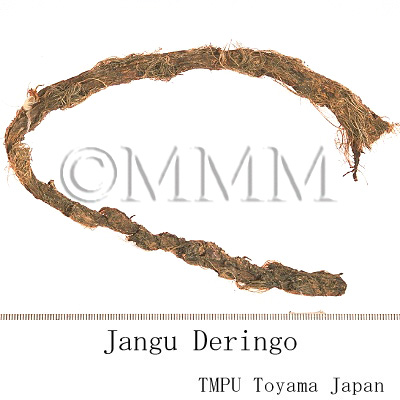Crude drug sample data base
※Click on the image to enlarge it.
The capital city, provincial capital city or the representative
location of its administrative area is indicated.
location of its administrative area is indicated.
Production area information
https://ethmed.toyama-wakan.net/img/pin_san.png
-7.2574719
112.75208829999997
Collection information
Republic of Indonesia,East Java Province
https://ethmed.toyama-wakan.net/img/pin_nyu.png
Scientific information data base
| Crude drug name | Indonesian name, English name | Dringo, Sweet flag | ||||
|---|---|---|---|---|---|---|
| crude drug image |
| |||||
| Original plant name | Acorus calamus Linn. | |||||
| Family name | Araceae | |||||
| Used part | Rhizome, leaves | |||||
| Distribution area | It is said to be native to China and India. It occurs throughout Indonesia; grows wild on humid and high places, such as on riverbanks, around lakes, near wells [201, 231]. | |||||
| Description | The plant is a perennial glabrous herb up to 150 cm tall. Rhizome creeping, extensively branched, pale yellowish to pinkish-brown outside, whitish, sometimes slightly pinkish inside. It has a citrun-like smell and bitter spicy taste. Leaves erect., linear-ensiform, obliquely acuminate apex, aromatic. Inflorescence arising from the rhizome, erect, flowers densely arranged on the spadix, bisexual. Fruit a 2-3-celled berry, turbinate and prismatic with pyramidal top [201, 205]. | |||||
| Drug effect | Neutralizing [205]. | |||||
| Specific actions | Anti-inflammatory, effective against skin diseases and stomach complaints [231]. | |||||
| Frequency in use | Moderate. | |||||
| Common uses | Chinese put the rhizomes under the pillows to remove bedbugs [201]. | |||||
| Pharmacological effect | Alpha and beta- azarone have psycho active effects [205]. The ethanolic extract of Acorus calamus inhibited proliferation of mitogen (phytohaemagglutinin) and antigen (purified protein derivative)-stimulated human peripheral blood mononuclear cells. It also inhibited several cell lines of mouse and human origin [PMID:12538034]. Lectins purified from rhizomes of Acorus calamus (Linn.) and Acorus gramineus (Solandin Ait.) showed potent mitogenic activity towards mouse splenocytes and human lymphocytes. Both also significantly inhibited the growth of a murine macrophage cancer cell-line and to lesser extent a B-cell lymphoma [PMID:15953573]. The ethanol : water (1:1) extract of rhizome of Acorus calamus has a neuroprotective efficacy in the rat model of ischaemia [PMID:16696294]. | |||||
| Medical system | Indonesian medicine (Jamu) | |||||
| Traditional usage | It is used externally to treat inflammation, rheumatism, lumbago, skin diseases. Internally, it is drunk after childbirth to enhance uterine cleansing; also to cure diarrhoea/diarrhea and splenomegaly. Leaves are grounded, add some water and alumn, and the paste obtained is put in the mouth cavity as a dental fillings; the decoction is used for inflammation [201]. It is now used as an ingredient of certain Javanese traditional medicine [201, 205]. | |||||
| Formulation | 1) Stomachache: 1 gram of rhizome and 5 grams of ginger are boiled or steeped with 110 ml of water. Stand to cool, strain. Drink 100 ml of the decoction once a day for 14 days [231]. 2) Sores, boils, abscesses: - Ingredients: rhizome of A. calamus, 1 onion, turmeric, wood of Strychnos ligustrina, 1/4 teaspoon of sulfur, 2 tablespoon of vaseline. - Preparation: all ingredients is wrapped with white cloth and heat in a bowl. Squeeze and stir to cool. Apply it to the affected areas. Repeat every 3 hours [231]. | |||||
| References | Reference book Tips! | [201] K. Heyne, Tumbuhan Berguna Indonesia, Vols. 1-4, 1987. Diedarkan Oleh Koperasi Karyawan Departemen Kehutanan, Jakarta, Indonesia. Vol. 1, p 492. [205] de Pdua, L.S., Bunyapraphatsara, N. and Lemmens, R.H.M.J. (Editors), 1990. Plant Resources of South-East Asia No. 12 (1). Medicinal and poisonous plants 1. Backhuys Publishers, Leiden, Netherlands. pp 81-85. [231] Soedibyo, Mooryati: Alam Sumber Kesehatan: Manfaat dan Kegunaan (Natural resources for health. Benefits and uses). Balai Pustaka. 1998. pp 168-169. | ||||
| Research paper | 1. Shukla PK, Khanna VK, Ali MM, Maurya R, Khan MY, Srimal RC. Neuroprotective effect of Acorus calamus against middle cerebral artery occlusion-induced ischaemia in rat. Hum Exp Toxicol. 25(4):187-94, 2006. (PMID: 16696294) 2. Bains JS, Dhuna V, Singh J, Kamboj SS, Nijjar KK, Agrewala JN. Novel lectins from rhizomes of two Acorus species with mitogenic activity and inhibitory potential towards murine cancer cell lines. Int Immunopharmacol. 5(9):1470-8, 2005. (PMID: 15953573) 3. Mehrotra S, Mishra KP, Maurya R, Srimal RC, Yadav VS, Pandey R, Singh VK. Anticellular and immunosuppressive properties of ethanolic extract of Acorus calamus rhizome. Int Immunopharmacol. 3(1):53-61, 2003. (PMID: 12538034) | |||||
| Remarks | [DNA sequences]: FJ874930, FJ874931, FJ874932, FJ874933, FJ874934, FJ874935, FJ874936, FJ874937, FJ874950, FJ874951, FJ874952, FJ874953, FJ874954, FJ874955, FJ874956, FJ874957, FJ874970, FJ874971, FJ874972, FJ874973, FJ874974, FJ874975, FJ874976, FJ874977, FJ874990, FJ874991, FJ874992, FJ874993, FJ874994, FJ874995, FJ874996, FJ874997, FJ875010, FJ875011, FJ875012, FJ875013, FJ875014, FJ875015, FJ875016, DQ008848, DQ008863, DQ008879, DQ008894, DQ008910, DQ008923, DQ008942 | |||||
| Last renewal date | 2024/03/05 | |||||








